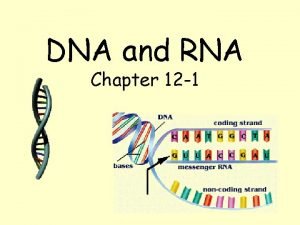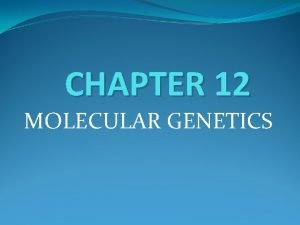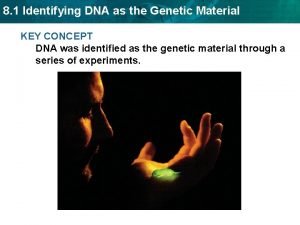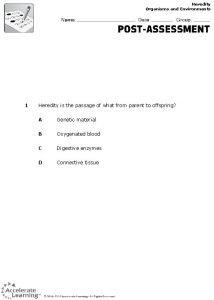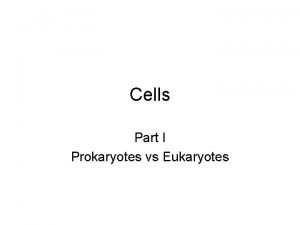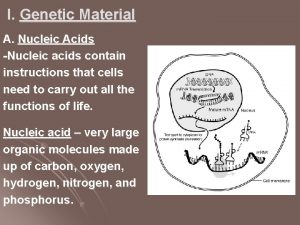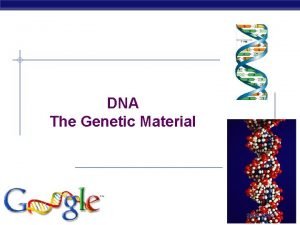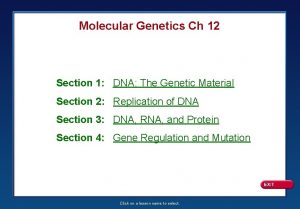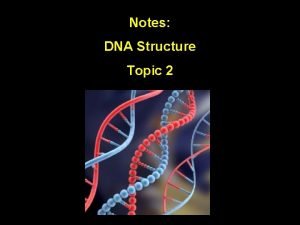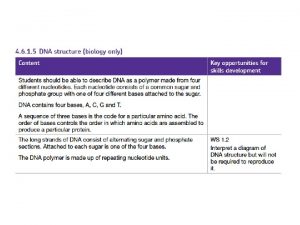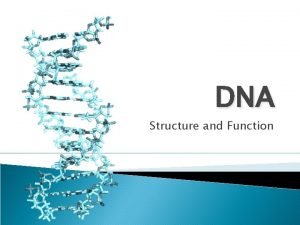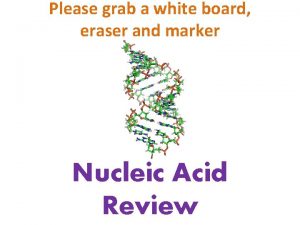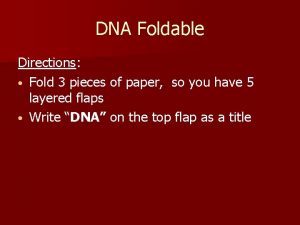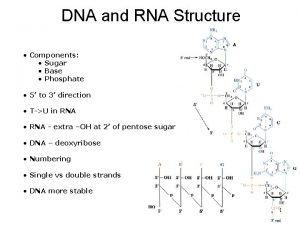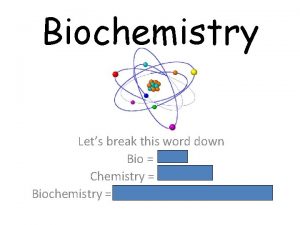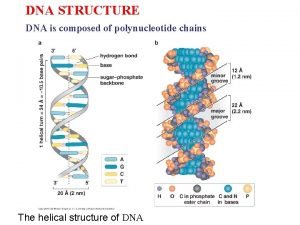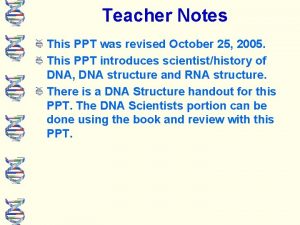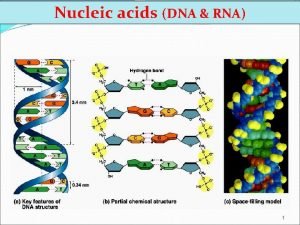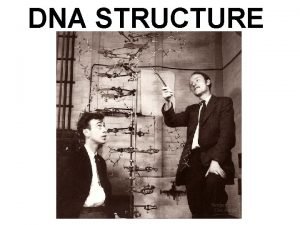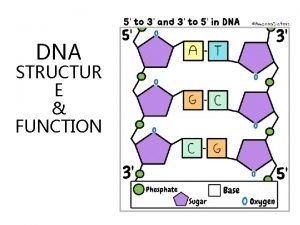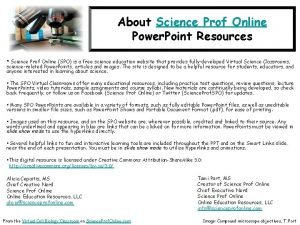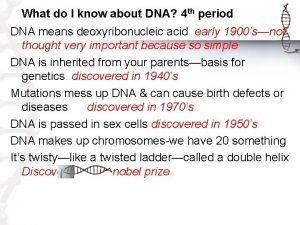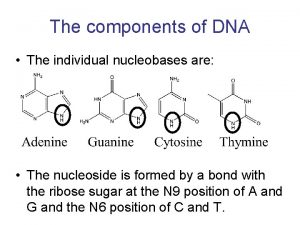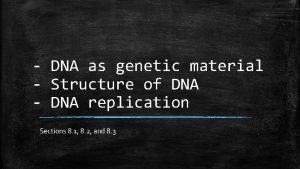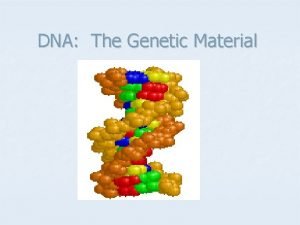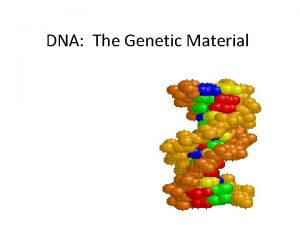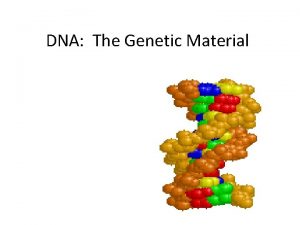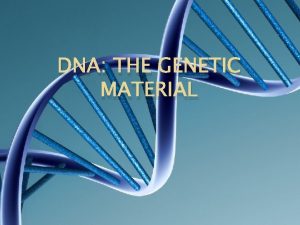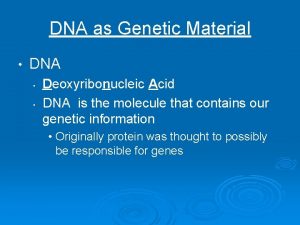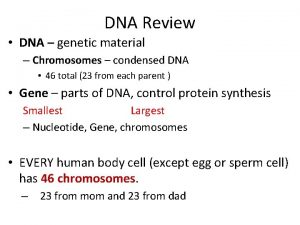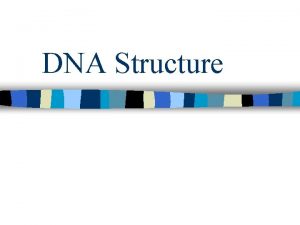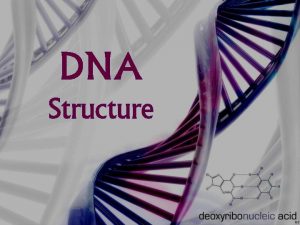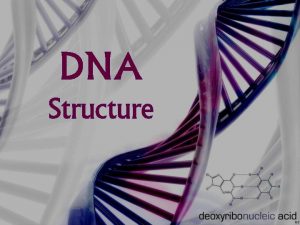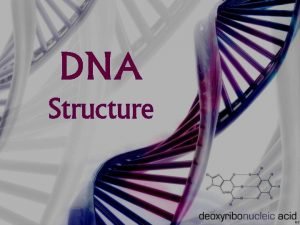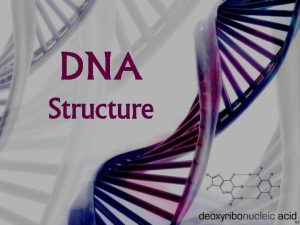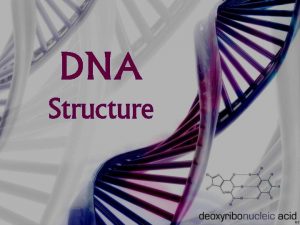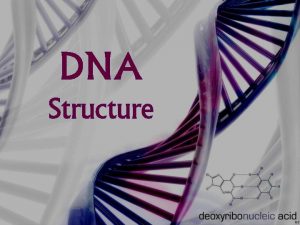THE STRUCTURE OF THE GENETIC MATERIAL DNA is















































- Slides: 47

THE STRUCTURE OF THE GENETIC MATERIAL

DNA is a Double-Stranded Helix § In 1953, James D. Watson and Francis Crick deduced the structure of DNA, using X-ray crystallography data of DNA from the work of Rosalind Franklin and Maurice Wilkins and Chargaff’s observation that in DNA the amount of adenine was equal to the amount of thymine and the amount of guanine was equal to that of cytosine.

DNA is a Double-Stranded Helix § Watson and Crick reported that DNA consisted of two polynucleotide strands wrapped into a double helix. – The sugar-phosphate backbone is on the outside. – The nitrogenous bases are perpendicular to the backbone in the interior. – Specific pairs of bases give the helix a uniform shape. – A pairs with T, with two hydrogen bonds – G pairs with C, with three hydrogen bonds

DNA and RNA are Polymers of Nucleotides § DNA and RNA are nucleic acids composed of long chains of nucleotides § A nucleotide contains a nitrogenous base, five-carbon sugar, and phosphate group § Nucleotides are joined to one another by a sugar-phosphate backbone. © 2012 Pearson Educaton, Inc.

§ Each DNA nucleotide has a different nitrogenous base: Adenine (A), Cytosine (C), Guanine (G) or Thymine (T) Nitrogenous base (A, G, C, or T) Thymine (T) Phosphate group Sugar (deoxyribose) DNA nucleotide

Nitrogenous Bases of DNA Thymine (T) Cytosine (C) Pyrimidines Guanine (G) Adenine (A) Purines

§ Each RNA nucleotide also has a different nitrogenous base: Adenine (A), Cytosine (C), Guanine (G) or Uracil (U) Nitrogenous base (A, C, G, or U) Sugar (ribose)

The DNA Molecule is Antiparallel § The polynucleotide strands of DNA run in opposite directions or, are antiparallel § DNA has 5’ (prime) and 3’ (prime) ends § The sugar on the 3’ end is attached to a hydroxyl group § The sugar on the 5’end is attached to a phosphate group

Phosphate group on 5’ end Hydrogen bonds G T C A A C T G Partial chemical structure Hydroxyl group on 3’ end

DNA REPLICATION

DNA Replication Depends on Specific Base Pairing Rules § DNA replication follows a Semiconservative Model § DNA strands separate and serve as templates for new DNA § Enzymes read parental strands and link nucleotides (according to base pairing rules) forming complementary strands § DNA replication follows a Semiconservative Model of replication because half of the parental molecule is kept (conserved) in each new DNA helix § DNA replication ensures that all somatic cells in a multicellular organism carry the same genetic information

A T G A A T Parental DNA molecule T A G C Daughter strand T C G T C A G C C Parental strand G C G G T C C T A G T A C C T A T G A T A A C A T G T Daughter DNA molecules

DNA Replication Proceeds in Two Directions at Many Sites Simultaneously § DNA replication begins at the origins of replication where, – DNA unwinds producing a replication bubble – Replication proceeds in both directions from the origin – Replication ends when products (new DNA) from the bubbles merge

Parental DNA molecule Origin of replication “Bubble” Two daughter DNA molecules Parental strand Daughter strand

Daughter Strand Synthesis in DNA Replication § Both daughter strands are synthesized 5’ to 3’; new nucleotides are only added to the 3’ end of a growing strand – The daughter strand that is synthesized toward the replication fork in one continuous piece is the leading strand – The daughter strand synthesized away from the replication fork in (Okazaki) fragments is the lagging strand – Lagging strand synthesis is due to the antiparallel nature of DNA

Daughter Strand Synthesis in DNA Replication

DNA polymerase molecule 5 3 3 5 Leading Strand Parental DNA Replication fork Lagging Strand 3 5 5 3 DNA ligase Overall direction of replication

DNA Replication Requires a Host of Enzymes § Important Enzymes are involved in DNA replication 1. Helicase-breaks H-bonds, unwinding (separating) the DNA double helix 2. Primase-lays down an RNA primer to provide a 3 prime end 3. DNA polymerase reads template strand adds nucleotides to a growing chain, proofreads and corrects improper base pairings 4. DNA ligase joins Okazaki fragments into a continuous DNA strand *DNA polymerases and DNA ligase also repair damaged DNA*

DNA Replication

THE FLOW OF GENETIC INFORMATION FROM DNA TO RNA TO PROTEIN

The DNA Genotype is Expressed as Proteins, Which Provide the Molecular Basis for Phenotypic Traits § Connections between genes and proteins: – In the 1940’s Beadle and Tatum hypothesized that one gene codes for one enzyme by doing studying inherited metabolic diseases – Their hypothesis is still accepted but with important changes: – The hypothesis includes all proteins and that one gene codes for one polypeptide

The DNA Genotype is Expressed as Proteins, Which Provide the Molecular Basis for Phenotypic Traits § DNA specifies traits by determining the sequence of amino acids in a protein; proteins give us our phenotype so genotype determines phenotype § The molecular chain of command is from DNA to RNA to protein § Transcription is the synthesis of RNA using DNA as a template. § Translation is the synthesis of proteins using RNA as a template.

DNA Transcription RNA NUCLEUS Translation Protein CYTOPLASM

Genetic Information in DNA is written in m. RNA as Codons §Instructions for an amino acid sequence of a polypeptide is written in DNA as three base sequences called triplets A A A C C G G C A A Transcription U U U G G C C G U U §In transcription triplets in DNA are copied into complementary three base sequences in m. RNA called codons §Each codon determines the amino acid to be added to a growing polypeptide chain – 64 codons are possible Translation Polypeptide amino acid 1 amino acid 2 amino acid 3 amino acid 4

Third base First base Second base

Transcription § RNA polymerase oversees transcription by – Unwinding DNA, reading DNA bases, and joining appropriate RNA nucleotides together § Transcription occurs in Three Phases: § Initiation - RNA pol. binds the promoter § Elongation - m. RNA strand grows longer § Termination –RNA pol. reaches the terminator sequence and detaches from m. RNA and the gene

RNA polymerase DNA of gene Promoter DNA 1 Initiation Terminator DNA

2 Elongation Area shown in Figure 10. 9 A Growing RNA

3 Completed RNA Termination Growing RNA polymerase

Eukaryotic m. RNA § Messenger RNA (m. RNA) – The RNA formed from transcription, carrying information to build a protein is called m. RNA – m. RNA carries the message from DNA (nucleus) to ribosomes (cytoplasm) – In prokaryotes transcription and translation occur at the same place and time – In eukaryotes, m. RNA exits nucleus via nuclear pores – Eukaryotic m. RNA has introns or interrupting sequences that separate exons or coding regions

Eukaryotic RNA is Processed Before Leaving the Nucleus § m. RNA processing : – Occurs in nucleus of eukaryotic cells – Involves the addition of extra nucleotides to the ends of m. RNA. A 5’ guanine cap and 3’ poly A tail helps to: – facilitate export of m. RNA from nucleus – protect m. RNA from attack by cellular enzymes – help ribosomes bind m. RNA § RNA splicing removes introns and joins exons to produce a continuous coding sequence.

Exon Intron Exon DNA Cap RNA transcript with cap and tail Transcription Addition of cap and tail Introns removed Tail Exons spliced together m. RNA Coding sequence NUCLEUS CYTOPLASM

The Genetic Code Dictates How Codons are Translated into Amino Acids § Translation involves switching from nucleotide “language” to amino acid “language” § t. RNA’s act as interpreters Amino acid attachment site § Transfer RNA (t. RNA) molecules read codons in m. RNA to help synthesize a polypeptide chain § Each t. RNA has a three base sequence or anticodon it uses to read an m. RNA codon Anticodon

Strand to be transcribed DNA T A C T T C A A T A T G A A G T T T C T A G Transcription RNA A U G A A G U U A G Translation Start codon Polypeptide Met Stop codon Lys Phe

The Genetic Code Dictates How Codons are Translated into Amino Acids § Characteristics of the Genetic Code § Three RNA nucleotides (one codon) specify one amino acid § AUG = the start codon signals the ribosome to start translating; AUG also codes for methionine § There are 3 “stop” codons that signal the ribosome to stop translating § The Genetic Code is: § Redundant, there is more than one codon for the same amino acid § Unambiguous, any codon for an amino acid does not code for any other amino acid § Nearly universal, the genetic code is shared by organisms from the simplest bacteria to the most complex plants and animals

Ribosomes Build Polypeptides With the Help of t. RNA’s § Translation occurs on the surface of a Ribosome. – Ribosomes have binding sites for m. RNA and t. RNA to coordinate protein synthesis – Ribosomes have small and large subunits composed of ribosomal RNA (r. RNA) and proteins Growing polypeptide The next amino acid to be added to the polypeptide t. RNA Codons m. RNA

Translation § Translation occurs in Three Phases § Initiation § An m. RNA molecule binds to a small ribosomal subunit and the first t. RNA binds to m. RNA at the start codon § The first t. RNA has the anticodon UAC § The large ribosomal subunit joins the small subunit, forming a functional ribosome § The first t. RNA occupies the P site, which will hold the growing polypeptide chain § The A site is available to receive the next t. RNA

Met Large ribosomal subunit Initiator t. RNA P site m. RNA U A C A U G Start codon 1 Small ribosomal subunit 2 U A C A U G A site

Translation § Elongation involves the addition of amino acids to the polypeptide chain. Each cycle of elongation has three steps. 1. Codon recognition: The anticodon of an incoming t. RNA molecule, (w/ its amino acid), pairs with the m. RNA codon in the A site of the ribosome. 2. Peptide bond formation: The new amino acid is joined to the chain held by t. RNA in A site. 3. Translocation: the P site t. RNA now lacking an amino acid leaves ribosome; the ribosome moves t. RNA (holding the polypeptide) from the A site to the P site.

Polypeptide P site m. RNA Amino acid A site Anticodon Codons 1 Codon recognition m. RNA movement Stop codon 2 New peptide bond 3 Translocation Peptide bond formation

Translation § Termination § The Ribosome reaches a stop codon § The completed polypeptide is freed from the last t. RNA § The ribosome splits into separate subunits

Protein Synthesis

Mutations Can Change the Meaning of Genes § A mutation is any change in the nucleotide sequence of DNA. § Mutations can be caused by – spontaneous errors that occur during DNA replication or crossing over – mutagens, like high-energy radiation (X-rays), UV light and chemicals, viruses

Mutations Can Change the Meaning of Genes § Mutations within a gene can be divided into two general categories. 1. Base substitutions involve the replacement of one nucleotide and its base pairing partner. Base substitutions may – Produce a silent mutation there is no effect on the polypeptide because the right amino acid is still added – Produce a missense mutation where the mutation causes the wrong amino acid to be added to the polypeptide – Produce a nonsense mutation where the mutation produces a stop codon in the m. RNA instead of an amino acid.



Mutations Can Change the Meaning of Genes 2. Mutations can result in deletions or insertions that may – Cause frame shift mutations that alter the reading frame (triplet grouping) of the m. RNA – This typically produces a nonfunctional polypeptide
 Chapter 12 section 1 dna the genetic material
Chapter 12 section 1 dna the genetic material Chapter 12 section 1 molecular genetics answer key
Chapter 12 section 1 molecular genetics answer key Chapter 12 section 1 dna the genetic material
Chapter 12 section 1 dna the genetic material Chapter 12 dna and rna section 12-1
Chapter 12 dna and rna section 12-1 Section 12-1 dna
Section 12-1 dna Section 1 identifying dna as the genetic material
Section 1 identifying dna as the genetic material Genetic drift
Genetic drift Genetic programming vs genetic algorithm
Genetic programming vs genetic algorithm Genetic programming vs genetic algorithm
Genetic programming vs genetic algorithm Gene flow vs genetic drift
Gene flow vs genetic drift Genetic drift vs genetic flow
Genetic drift vs genetic flow Heredity is best described as
Heredity is best described as Chapter 3 cells and tissues
Chapter 3 cells and tissues Which part of the cell contains genetic material
Which part of the cell contains genetic material Genetic material
Genetic material Genetic material
Genetic material Molecular genetics chapter 12
Molecular genetics chapter 12 Dna polymerase function in dna replication
Dna polymerase function in dna replication Bioflix activity dna replication lagging strand synthesis
Bioflix activity dna replication lagging strand synthesis Coding dna and non coding dna
Coding dna and non coding dna Enzyme involved in dna replication
Enzyme involved in dna replication Dna rna protein synthesis homework #2 dna replication
Dna rna protein synthesis homework #2 dna replication Gd&t symbols
Gd&t symbols Usage variance formula
Usage variance formula Cultural relativism definition
Cultural relativism definition What is real culture
What is real culture Non material culture examples
Non material culture examples Enumerate some useful and harmful materials
Enumerate some useful and harmful materials Forms of dna
Forms of dna Pentose sugar structure in dna
Pentose sugar structure in dna Label dna molecule
Label dna molecule Lego ppt
Lego ppt Which base always base pairs with guanine?
Which base always base pairs with guanine? Multiple choice questions on dna structure and replication
Multiple choice questions on dna structure and replication Who discovered the structure of dna
Who discovered the structure of dna Dna structure labeled hydrogen bonds
Dna structure labeled hydrogen bonds Dna structure foldable
Dna structure foldable Dna bond structure
Dna bond structure Dna structure labeled
Dna structure labeled Structure of dna
Structure of dna Dna structure ppt
Dna structure ppt Types of rna and dna
Types of rna and dna Dna meaning
Dna meaning Nucleic acid dna structure
Nucleic acid dna structure Nucleic acid dna structure
Nucleic acid dna structure Structure of dna
Structure of dna Components of rna
Components of rna What is this
What is this



